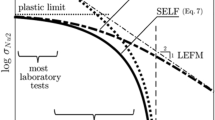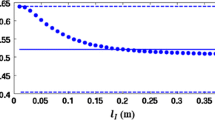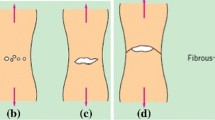Abstract
Karihaloo recently published an analytical study of the size effect in concrete based on large-size asymptotic approximations of the cohesive crack model. From this analysis, he concluded that the nominal strength can be determined only for sizes above a certain lower bound, large enough to invalidate, at least for concrete, all the existing experimental methods based on size effect measurements, such as the size effect method of Bažant or the general bilinear fit method of Planas, Guinea and Elices. The purpose of this paper is to show that this conclusion is misleading, and to explain why.
Similar content being viewed by others
References
Bažant, Z.P. (1984). Size effect in blunt fracture: Concrete, rock, metal. J. of Engng. Mechanics ASCE 110, 518–535.
Bažant, Z.P. (1999). Size effect on structural strength; a review. Archives of Applied Mechanics 69, 703–725.
Bažant, Z.P. and Beissel, S. (1994). Smeared-tip superposition method for cohesive fracture with rate effect and creep. International Journal of Fracture 65, 277–290.
Bažant, Z.P. and Kazemi, M.T. (1990). Determination of fracture energy, process zone length and brittleness number from size effect, with application to rock and concrete. International Journal of Fracture 44, 111–131.
Bažant, Z.P. and Li, Y-N. (1995). Stability of cohesive crack model: Part II – Eigenvalue analysis of size effect on strength and ductility of structures. Transactions of the ASME. Journal of Applied Mechanics 62, 965–969.
Bažant, Z.P. and Planas, J. (1998). Fracture and Size Effect in Concrete and Other Quasibrittle Materials. CRC Press, Boca Raton.
Bažant, Z.P., Kim, J-K. and Pfeiffer P.A. (1986). Nonlinear fracture properties from size effect tests. Journal of Structural Engineering-ASCE 112, 289–307.
Guinea, G.V., Planas, J. and Elices, M. (1994). A general bilinear fit for the softening curve of concrete. Materials and Structures 27, 99–105.
Horii, H., Hasegawa, A. and Nishino, F. (1989). Fracture process and bridging zone model and influencing factors in fracture of concrete. Fracture of Concrete and Rock. (Edited by Shah, S.P. and Swartz, S.E.), Springer-Verlag, New York, pp. 205–214.
Karihaloo, B.L. (1999). Size effect in shallow and deep notched quasi-brittle structures. International Journal of Fracture 95, 379–390 (special issue on Fracture Scaling edited by Z.P. Bažant and Y.D.S. Rajapakse).
Petersson, P.-E. (1981). Crack Growth and Development of Fracture Zone in Plain Concrete and SimilarMaterials. Report No. TVBM-1006, Division of Building Materials, Lund Institute of Technology, Lund, Sweden.
Planas, J. (1989). Summary of the discussions on: Micromechanics and Micro-Macro Relationships. Part 1. In Cracking and Damage, Strain Localization and Size Effect. (Edited by Mazars, J. and Bažant, Z.P.), Elsevier Applied Science, London, pp. 499–513.
Planas, J. and Elices, M. (1991). Nonlinear fracture of cohesive materials. International Journal of Fracture 51, 139–157.
Planas, J. and Elices, M. (1992). Asymptotic analysis of a cohesive crack: 1. Theoretical background. International Journal of Fracture 55, 153–177.
Planas, J. and Elices, M. (1993). Asymptotic analysis of a cohesive crack: 2. Influence of the softening curve. International Journal of Fracture 64, 221–237.
Planas, J., Guinea, G.V. and Elices, M. (1999a). Size effect and inverse analysis in concrete fracture. International Journal of Fracture 95, 367–378.
Planas, J. Guinea, G.V. and Elices, M. (1999b). Integral equation method for modeling cracking in concrete. In Computational Fracture Mechanics in Concrete Technology, (Edited by Carpinteri, A. and Aliabadi, M.H.), WIT Press/Computational Mechanics Publications, Boston, Southampton, pp. 103–131.
RILEM (1990). Size-effect method for determining fracture energy and process zone size of concrete. Materials and Structures 23, 461–465.
Smith, E. (1994a). The elastically equivalent softening zone size for an elastic-softening material I. Power law softening behaviour. Mechanics of Materials 17, 363–368.
Smith, E. (1994b). The elastically equivalent softening zone size for an elastic softening material: II. A simple piece-wise softening law. Mechanics of Materials 17, 369–378.
Smith, E. (1995). Recent research on the cohesive zone description of an elastic softening material. In Fracture of Brittle Disordered Materials: Concrete, Rock, Ceramics. (Edited by Baker, G. and Karihaloo, B.L.). E & FN Spon, London, pp. 450–463.
Author information
Authors and Affiliations
Rights and permissions
About this article
Cite this article
Planas, J., BaŽant, Z. & Jirásek, M. Reinterpretation of Karihaloo's size effect analysis for notched quasibrittle structures. International Journal of Fracture 111, 17–28 (2001). https://doi.org/10.1023/A:1010994324959
Issue Date:
DOI: https://doi.org/10.1023/A:1010994324959




